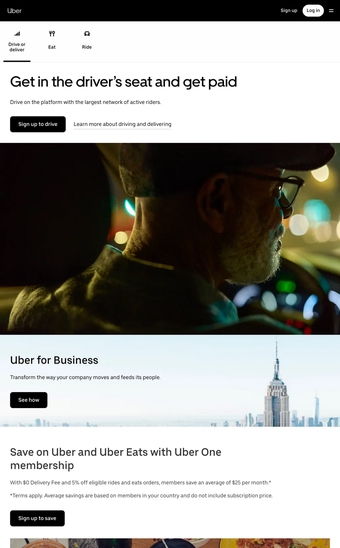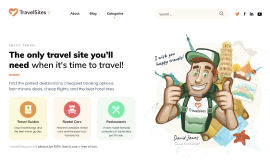Uber
uber.comUber is a taxi-hailing app that was founded in 2009 and now operates in more than 630 cities around the world, employing over 12,000 drivers. It is free to download and has, ultimately, changed the way in which people get around.
One of the best features of Uber is the rating system used for drivers and passengers. After each journey, passengers can rate the quality of their trip using a star system out of five, while drivers can do the same. The average score across all the journeys is totaled and must stay above the minimum set by the city they are operating in, otherwise, they will be deactivated as a driver. This ensures good quality service, as the drivers are operating under pressure to give the best journey possible in order to avoid losing their job, unlike traditional cab drivers who do not rely on reviews.
Another benefit is that not only is it very easy to quickly request an Uber without having to find out a phone number or go to a taxi rank, it is also a very affordable service in comparison to established taxi companies. You can find out estimates for journeys and, if you are not so budget restricted, search for premium cars or use UberXL that offers SUVs and minivans.
However, one of the downsides is that Uber often applies surge pricing that is based on a supply and demand principle, meaning that if lots of people are requesting a taxi at the same time, prices can increase dramatically, making it more expensive than a traditional taxi service.
Furthermore, Uber is not available in all cities and in some it is even illegal. As it is difficult for local councils to control, drivers sometimes operate regardless, making for a tense journey, whereas traditional taxi companies exist even in the smallest of towns.
Uber is a taxi-hailing app that was founded in 2009 and now operates in more than 630 cities around the world, employing over 12,000 drivers. It is free to download and has, ultimately, changed the way in which people get around.
One of the best features of Uber is the rating system used for drivers and passengers. After each journey, passengers can rate the quality of their trip using a star system out of five, while drivers can do the same. The average score across all the journeys is totaled and must stay above the minimum set by the city they are operating in, otherwise, they will be deactivated as a driver. This ensures good quality service, as the drivers are operating under pressure to give the best journey possible in order to avoid losing their job, unlike traditional cab drivers who do not rely on reviews.
Another benefit is that not only is it very easy to quickly request an Uber without having to find out a phone number or go to a taxi rank, it is also a very affordable service in comparison to established taxi companies. You can find out estimates for journeys and, if you are not so budget restricted, search for premium cars or use UberXL that offers SUVs and minivans.
However, one of the downsides is that Uber often applies surge pricing that is based on a supply and demand principle, meaning that if lots of people are requesting a taxi at the same time, prices can increase dramatically, making it more expensive than a traditional taxi service.
Furthermore, Uber is not available in all cities and in some it is even illegal. As it is difficult for local councils to control, drivers sometimes operate regardless, making for a tense journey, whereas traditional taxi companies exist even in the smallest of towns.







